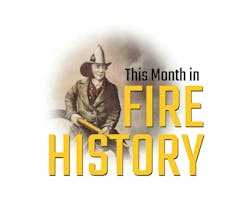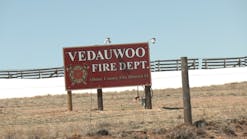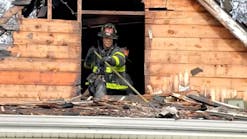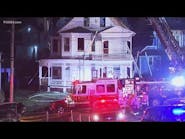The month of February has historical significance in the fire service. The Station Nightclub Fire was one of this country’s deadliest fires. Internationally, Australia's Black Saturday devasted that country. Several other fires took the lives of too many of our bravest. Here is a look at some of those fires.
Feb. 7, 2009, Victoria, Australia—Australia’s Black Saturday
In January 2009, a heatwave struck southeastern Australia. Melbourne suffered through three straight days near 110 degrees Fahrenheit, peaking at 113 degrees on Jan. 30, according to Wikipedia.
These temperatures combined with extremely low levels of humidity to create tinder-dry conditions in the Victorian bush, causing Premier John Brumby to issue a public warning on Feb. 6 that the next day was expected to be the ‘worst day [for fire conditions] in the history of the state’.
On Feb. 7, 60 mph winds brought down powerlines in Kilmore East, sparking a fire that spread quickly entering Kinglake National Park.
Simultaneously, the Murrindindi fire began and spread through the Murrindindi State Forest and Black Range.
Eventually, the Kilmore East and Murrindindi fires merged, becoming the Kinglake Fire Complex, which swept through state forests and national parks with flames recorded at 90 feet in height.
Despite the efforts of more than 19,000 Country Fire Authority members, the fires continued to burn. It would take weeks before weather changes, reduction of fuel loads and human intervention extinguished the fires.
The Black Saturday bushfires killed 173 people, 120 in the Kinglake area alone. Another 414 people were injured. More than 1 million acres had burned and 3,500 buildings, including more than 2,000 houses, were destroyed. It was estimated that up to 1 million wild and domesticated animals died in the disaster.
Feb. 14, 1995, Pittsburgh—Bricelyn Street Fire
On Feb. 14, 1995, a tragic fire occurred at 8361 Bricelyn Street in Pittsburgh. According to a U.S. Fire Administration report, three Pittsburgh firefighters died when they ran out of air and were unable to escape from the interior of a burning dwelling.
As firefighters attempted to suppress the blaze, they became trapped in the lower level of the building.
The three victims were all assigned to Engine Company 17 and had advanced the first hoseline into the house to attack an arson fire in the basement. When found, all three were together in one room and had exhausted their air supplies. Three other firefighters had been rescued from the same room, which caused confusion over the status of the initial attack team.
The firefighters who lost their lives were:
- Capt. Thomas Brooks
- Firefighter Patricia Conroy
- Firefighter Marc Kolenda
The Bureau of Alcohol, Tobacco, Firearms and Explosives (ATF) quickly determined the fire to be arson. Evidence collected from the scene, including samples from the basement, tested positive for the presence of gasoline.
The investigation focused on the tenants of the property, Darlene Buckner and her 17-year-old son, Gregory Brown.
Investigators suspected that the fire was set to collect insurance proceeds.
In April 1996, Buckner and Brown were arrested and charged with three counts of 2nd degree homicide, arson, conspiracy, and insurance fraud. After a three-week joint trial in 1997, both were convicted.
In 2016, Charlie Dickinson, who was chief of the Pittsburgh Fire Department when the Bricelyn Street Fire occurred, wrote an article for Firehouse.com about an eerily similar fire in Oneida, NY.
Feb. 14, 2000, Houston—McDonald’s Restaurant Fire
At 4:33 a.m. on Feb. 14, 2000, the crew of Houston Fire Department Engine and Ladder 76 responded to a fire at a local fast-food restaurant.
Firefighters Kimberly Smith, 30, and Lewis Mayo III, 44, both from Engine 76, entered the restaurant with a team to battle the flames and conduct a primary search.
A report by retired firefighter Scott Mellott stated that “as Mayo and Smith headed toward the rear of the restaurant, the suspended ceiling along with the air conditioning ducts fell in, trapping the two firefighters. Mayo was covered by the ceiling and was soon located and was transported to Herman Hospital by Medic 75.”
He was pronounced dead at the hospital.
The report states that “Smith was also covered by the fallen roof; however, her escape path was blocked. She managed to free herself and headed toward the rear of the restaurant desperately, looking for a way out. When the area of the roof containing the air conditioning fell in, this fueled the fire causing it to intensify and engulfing Smith after she was unable to find her way to safety.”
Nearly four hours later, Smith's body was found in the burned debris.
Smith was the first female Houston firefighter killed in the line of duty.
The fire was later determined to be arson trying to cover up a failed robbery attempt. Three young men were later found guilty of felony murder and arson charges.
Feb. 20, 2003, West Warwick, RI—The Station Nightclub Fire
On Feb. 20, 2003, people crowded into a Rhode Island nightclub to gather with friends and see a performance by the rock band Great White. During the show, someone set off pyrotechnics, which ignited the flammable polyurethane foam insulation on the club’s walls and ceiling. The fire spread rapidly, releasing toxic smoke as it burned. The club was not equipped with sprinklers and soon lost power.
Panic set in as the crowd scrambled in the dark, choking from the thick toxic smoke to find a way out. Although there were other exits, many headed toward the main entrance, where they had entered.
In the end, 100 people did not make it out. More than 200 others were injured in what became the fourth deadliest nightclub blaze in U.S. history.
The club’s owners and the band’s manager faced criminal charges, and the incident led to changes in safety regulations.
On the fifth anniversary of the fire, Susan Nicol talked to some of the survivors who shared their memories of that tragic day.
On Feb. 27, 2003, a NIST team was directed to investigate the fire. They filed this report.
Feb. 24, 1989, Lake Buena Vista, FL—Gift Shop Fire
Shortly after 4 p.m. on Feb. 24, 1989, Orange County Fire and Rescue Engine 36 was dispatched to a reported fire at the Sunrise Gift Center in Lake Buena Vista, FL.
Acting Lt. Todd Aldridge, firefighter/paramedic Mark Benge, and firefighter Richard Marcotte entered the building with a 1¾-inch hoseline and began attacking the fire. Less than 10 minutes later, part of the roof collapsed, trapping Aldridge and Benge. Marcotte was able to use his SCBA to smash through a glass door and escape.
As other firefighters attempted to position another handline, the roof became totally involved and further collapsed.
Tragically, Aldridge and Benge were killed.
Aldridge and Benge were memorialized in Florida law in 2009 when state legislators passed the Aldridge-Benge Firefighter Safety Act, which requires commercial, industrial and multi-unit residential buildings to be marked with a warning placard if the structures were built with lightweight floor and roof trusses prone to collapse during a fire.
Thiry years after their deaths, the fallen firefighters were honored when Orange County renamed part of Forsythe Road after them.
The county chose the stretch of Forsythe Road between University Boulevard and East Colonial Drive to honor the firefighters’ legacy because the road is a route to Orange County Fire Rescue Headquarters and the department’s training facility.
Orange County firefighters also now participate in exercises called the “Honor Challenge,” which simulate the situation faced by Aldridge and Benge 30 years ago.
“We’re teaching them to extricate themselves from the dangers Todd and Mark faced that day,” Orange County Fire Chief Otto Drozd III said during the 30th anniversary remembrance. “It’s very important we learn from the past to ensure our future.”
Other Notable February Fires
Feb. 2, 1978, Chester, PA—Wade Dump Fire leads to cancer deaths of 20 first responders
Feb. 7, 1904, Baltimore, MD—Great Baltimore Fire destroys more than 1,500 buildings
Feb. 18, 1969, Crete, NE—Anhydrous ammonia train derailment kills 9
Feb. 23, 1991, Philadelphia, PA—One Meridian Plaza high-rise fire kills 3 firefighters







